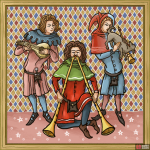Text
Theatre as we know it today was not widespread in the Middle Ages and was used more for church purposes (passion plays). Art in the high court, on the other hand, was not comprehensible to commoners, so the profession of folk entertainer was established for a variety of purposes.
Minstrels were seen at fairs and markets; they made the rounds of taverns and were even hired by wealthy merchants or nobles. The minstrel’s repertoire could include singing, playing musical instruments, juggling, staging scenes or narrating humorous stories.
The themes of their work were mostly light and cheerful, but often included satire or criticism of political conditions, whether coming from the minstrels themselves, or paid for by an employer and tailored to their intentions. Most of the minstrels had no employer, they belonged to the margins of society and had to get by from day to day through alms.
Musicians enjoyed a bit more respect and besides entertainment, their music could also be used during religious services. Popular medieval instruments included flutes, trumpets, shawms, as well as lutes, harps and drums. Their performances were mostly improvised, but early musical notations also began to appear at this time.
There were both, professional musicians employed at court or churches and travelling musicians playing in markets and at celebrations. This craft was predominantly pursued by men.


No Comments